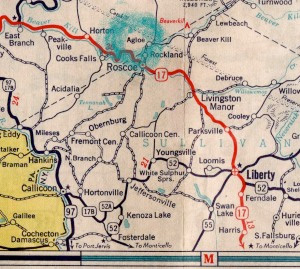The Fake Town That Became Real (Briefly)
Travelers starting in the New York City area and making their way to western New York State — perhaps to a resort in the Catskills or to Binghamton University — may end up stopping at the Roscoe Diner. The diner sits on Route 17, one of the main thoroughfares between the city and points westward. It has a reputation that extends for miles, in part because you can get some generally very good (and thick) French toast there. But otherwise, you are kind of in the middle of nowhere. Roscoe, the town (and it’s not really a town, but a “census-designated place”), has only 900 or so residents. And the nearby municipality of Agloe, circled on the map below, has even fewer. No one lives there.
But that’s because it only kind of exists.

If two companies make a map of the same area but do so independently of each other, the maps should have some identical data. Towns and roads and bodies of water need to be represented accurately or drivers and others using the maps to navigate their surroundings will certainly get lost. Sure, you can add a little bit of creativity when it comes to the choice of colors, fonts, or line thickness, but the locations of things have to be right or the map won’t be very useful.
As a consequence of this, it’s very easy for a third party to start making maps — they simply have to copy the data from any other reliable map and reproduce it. To some degree, copyright law should prevent this, but outright copying isn’t so easy to prove. As a solution, some mapmakers add fake streets (called “trap streets”) or even fake towns (often called “paper towns”) into their maps. If someone came by and copied their work, they’d also copy the fictional creation unique to the original map maker’s craft.
According to novelist and YouTube celeb John Green in a TEDx talk (video here), the General Drafting Company in 1937 did just this with the town of Agloe, creating it out of thin air at the intersection of two dirt roads just a few miles from Roscoe. (Green later used Agloe as well — as one of the locations for his novel, and the inspiration for its title, “Paper Towns.”) And a few decades later, Agloe appeared again, but this time on a map made by a different, unrelated company — Rand McNally. General Drafting thought they had caught Rand McNally red-handed, but Rand McNally had an incredibly good and surprising defense:
The county clerk’s office had given them the information.
It turns out that, in the early part of the 1950s, someone armed with the General Drafting map went to visit Agloe. Seeing nothing there, they figured that opportunity had knocked. This lost-to-history fellow, likely figuring that others would also come to Agloe — it was on the map, after all! — would expect to find something there. So he opened a small shop and called it the “Agloe General Store.” Over the next forty years, the fictional town of Agloe grew. As Green notes, at its largest, Agloe had a gas station, the general store, and two houses. Most importantly, at least as far as Rand McNally was concerned, Agloe had something else — the attention of the county administrators. They considered Agloe a real place, and therefore, so did Rand McNally’s team of cartographers.
Today? Agloe is sadly gone. The buildings are abandoned if not destroyed, and the mapmakers of the world no longer recognize its existence.
Bonus Fact: Orbiting the Earth right now is a satellite called LAGEOS, which contains a plaque designed by the late astronomer Carl Sagan. The plaque, seen here, is effectively a map, designed to show what the arrangement of the continents looked like when the satellite was placed into orbit. Why include this? LAGEOS is expected to return to Earth in about 8 million years (due to orbital decay), and when it does, the map will tell whomever or whatever discovers it the epoch from which it came.
From the Archives: The Middle of Nowhere: The town formerly in Google Maps which wasn’t there.
Related: “Paper Towns” by John Green. 4.4 stars on nearly 700 reviews.
